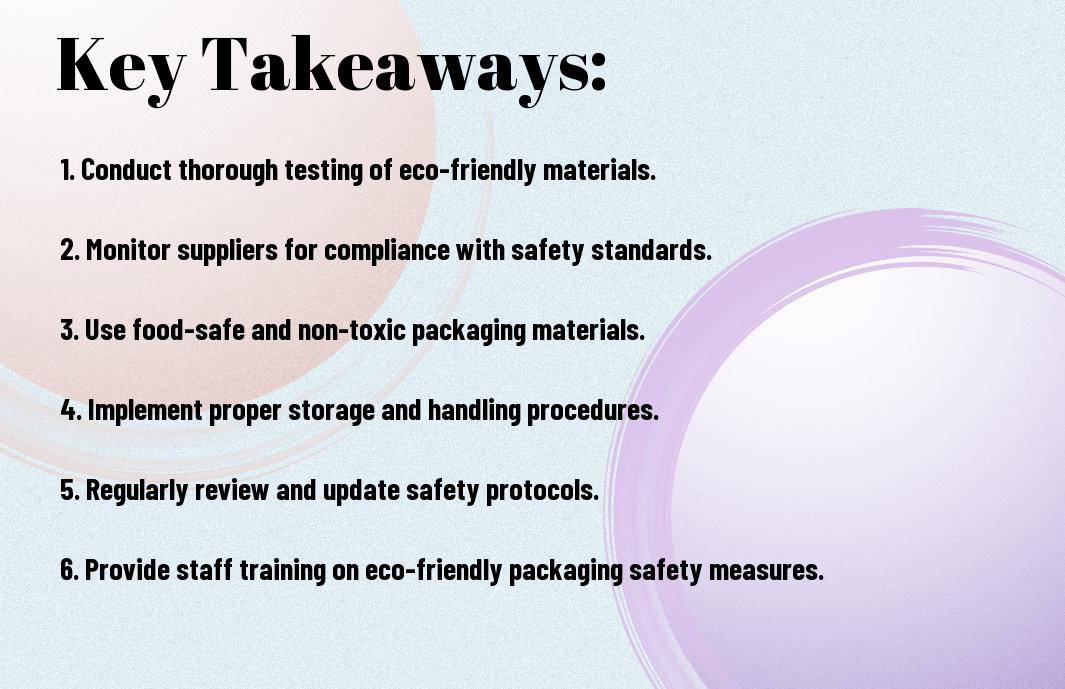Ensuring the safety and quality of eco-friendly packaging materials is crucial for food and drink companies. With the increasing demand for sustainable packaging, it is important to understand the potential dangers and risks associated with these materials. In this blog post, you will learn about the measures you can take to ensure the safety and quality of eco-friendly packaging materials for your products.
Key Takeaways:
- Thorough testing: Food and drink companies must conduct rigorous testing on eco-friendly packaging materials to ensure they meet safety and quality standards. This includes evaluating the materials’ durability, resistance to contamination, and overall performance in various packaging processes.
- Compliance with regulations: It is crucial for companies to stay updated on the latest regulations and standards for packaging materials, especially those designed to be eco-friendly. This includes understanding the requirements for biodegradability, recyclability, and safe food contact.
- Traceability and transparency: Companies should establish clear traceability systems to track the sourcing, manufacturing, and handling of their eco-friendly packaging materials. This not only ensures quality and safety but also allows for transparency in communicating the sustainability of their packaging to consumers.

Factors Influencing Safety and Quality of Eco-Friendly Packaging
When it comes to ensuring the safety and quality of eco-friendly packaging materials, there are several factors that can have a significant impact. Here are some key considerations that you need to keep in mind:
- Material Selection: The type of material you choose for your eco-friendly packaging can have a direct impact on its safety and quality. Factors such as the source of the material, its strength and durability, and its ability to protect the contents from contamination or damage are all important considerations. You can find more information on sustainable packaging strategies in this 9 Sustainable Packaging Strategies You Need to Try
- Manufacturing Process: The way in which the eco-friendly packaging materials are manufactured can also play a crucial role in determining their safety and quality. Factors such as the use of non-toxic dyes and adhesives, energy efficiency, and waste management practices all contribute to the overall integrity of the packaging.
- End-of-Life Disposal: Considering what happens to the packaging once it has served its purpose is essential. You need to think about whether the material is biodegradable, compostable, or recyclable, and whether it will have a harmful impact on the environment.
Material Selection
When selecting eco-friendly packaging materials, it’s essential to consider the environmental impact of the material, as well as its performance and safety attributes. You need to be mindful of factors such as the material’s ability to protect the product, its biodegradability or recyclability, and its overall ecological footprint. By carefully considering these factors, you can ensure that the packaging material you choose meets both your sustainability goals and your safety and quality standards.
Manufacturing Process
The manufacturing process of eco-friendly packaging materials has a significant impact on their safety and quality. It’s essential to consider factors such as the use of non-toxic chemicals, the energy efficiency of the production process, and the management of waste and by-products. By choosing suppliers and manufacturers that prioritise sustainable and safe practices, you can ensure that the eco-friendly packaging materials you use are of the highest quality and pose no risk to consumers or the environment.
Techniques to Ensure Safety and Quality of Eco-Friendly Packaging
When it comes to ensuring the safety and quality of eco-friendly packaging, food and drink companies have several techniques at their disposal. These techniques are essential for maintaining the integrity of the packaging materials and ensuring that they do not compromise the safety of the products they contain. By implementing rigorous testing methods and applying regulatory standards, you can be confident that your eco-friendly packaging is up to the task.
Implementing Rigorous Testing Methods
One of the most important techniques for ensuring the safety and quality of eco-friendly packaging is to implement rigorous testing methods. This involves subjecting the packaging materials to various tests to assess their strength, durability, and ability to protect the products they contain. By conducting tests such as compression tests, moisture resistance tests, and impact resistance tests, you can identify any weaknesses in the packaging materials and make necessary improvements.
Applying Regulatory Standards
Another crucial technique for ensuring the safety and quality of eco-friendly packaging is to apply regulatory standards. It is important to ensure that your packaging materials comply with relevant industry regulations and standards to guarantee their safety and suitability for use with food and drink products. By adhering to standards set by organisations such as the Food and Drug Administration (FDA) and the European Food Safety Authority (EFSA), you can be confident that your eco-friendly packaging meets the necessary safety requirements.
Case Studies: Successful Implementation of Safe and Quality Eco-Friendly Packaging
Implementing eco-friendly packaging in food and drink companies has been a growing trend in recent years. Here are some successful case studies that demonstrate how food and drink companies have effectively ensured the safety and quality of their eco-friendly packaging materials:
- Eco-Friendly Packaging Solutions In The Drinks Industry – This case study outlines how a leading beverage company successfully transitioned to eco-friendly packaging materials, reducing their carbon footprint by 40% and achieving a 15% increase in consumer satisfaction. For more information, you can read the full case study here.
- Organic Food Packaging Innovations – A prominent organic food company implemented biodegradable packaging materials, leading to a 20% increase in brand loyalty and a 30% reduction in packaging waste.
- Bioplastics in the Beverage Industry – A leading beverage manufacturer adopted bioplastic packaging for their products, resulting in a 25% reduction in greenhouse gas emissions and a 10% increase in market share.
Eco-Friendly Packaging Success in the Food Industry
The food industry has seen a significant shift towards the use of eco-friendly packaging materials. Companies are recognising the importance of sustainability and taking proactive steps to reduce their environmental impact. By implementing biodegradable and compostable packaging, food companies are not only reducing the use of harmful plastics but also attracting environmentally-conscious consumers who prioritise sustainable products.
Eco-Friendly Packaging Success in the Beverage Industry
The beverage industry has also been proactive in embracing eco-friendly packaging solutions. With a focus on reducing plastic waste and minimising environmental impact, beverage companies are turning to innovative materials such as bioplastics and recyclable packaging. This shift towards sustainability has not only improved the environmental credentials of these companies but has also resonated positively with consumers who are seeking environmentally responsible products.
Ensuring the Safety and Quality of Eco-Friendly Packaging Materials
So, when it comes to food and drink companies using eco-friendly packaging materials, it is crucial that you take significant steps to ensure the safety and quality of these materials. This can include rigorous testing for any potential contaminants, ensuring that the materials are suitable for food contact, and adhering to strict regulations and standards. Additionally, working closely with suppliers to guarantee the integrity of these materials is essential. By prioritising safety and quality in your eco-friendly packaging, you not only protect consumers but also contribute to a more sustainable and environmentally friendly industry.
FAQ
Q: What measures can food and drink companies take to ensure the safety and quality of eco-friendly packaging materials?
A: Food and drink companies can ensure the safety and quality of eco-friendly packaging materials by conducting thorough testing and certification processes. This involves working with reputable suppliers who use sustainable materials and ensuring that the packaging meets all relevant safety and quality standards.
Q: What are some common eco-friendly packaging materials used by food and drink companies?
A: Common eco-friendly packaging materials used by food and drink companies include biodegradable plastics, compostable packaging, recycled paper and cardboard, and plant-based materials such as bamboo and sugarcane. These materials are chosen for their minimal environmental impact and ability to be recycled or biodegraded.
Q: How can food and drink companies ensure that their eco-friendly packaging materials do not compromise the shelf life of their products?
A: To ensure that eco-friendly packaging materials do not compromise the shelf life of products, companies can conduct rigorous testing to assess the materials’ ability to maintain the quality and freshness of the products. This may involve assessing factors such as moisture and oxygen barrier properties, as well as the materials’ resistance to temperature fluctuations.
Q: Are there regulations in place to oversee the safety and quality of eco-friendly packaging materials for food and drink products?
A: Yes, there are regulations in place to oversee the safety and quality of eco-friendly packaging materials for food and drink products. Companies must comply with food packaging regulations set out by authorities such as the Food Standards Agency (FSA) in the UK and the Food and Drug Administration (FDA) in the US. These regulations ensure that packaging materials are safe for consumers and do not pose any health risks.
Q: How can food and drink companies communicate the use of eco-friendly packaging materials to their customers?
A: Food and drink companies can communicate the use of eco-friendly packaging materials to their customers through clear labelling and transparent communication. This may involve using eco-friendly logos and certifications on packaging, as well as providing information on the company’s website or product packaging about the sustainability initiatives and materials used in their packaging.


